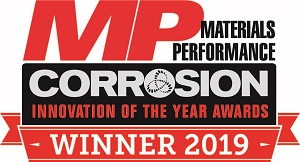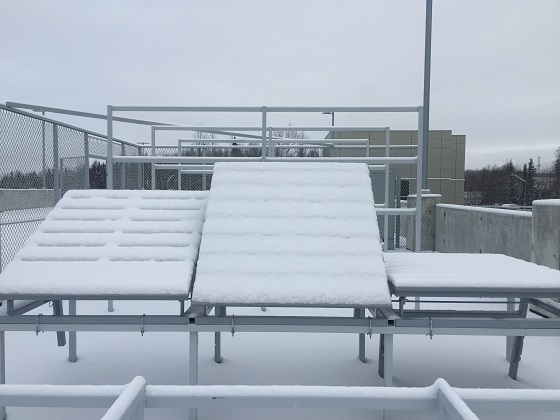An adjustable atmospheric corrosion test rack system created by an Alaskan university team is currently being tested in Arctic conditions in an effort to better identify weather parameters and their primary effect on corrosion in extremely cold climates.
The test rack, which was one of 10 winners in the 2019 MP Corrosion Innovation of the Year Awards program, is 46 by 46 in (1.2 by 1.2 m) and can be adjusted to angles of 0, 30, and 45 degrees to the horizontal, similar to a car hood. Full mechanical details on the test rack are available at the awards web site.
Technical Features
 “The angle of exposure affects the snow/ice retention, and this leads to the formation of varying thicknesses of moisture on the metal surface,” explains Raghu Srinivasan, an assistant professor in the Engineering Department at the University of Alaska Anchorage (Anchorage, Alaska, USA), where the rack was developed. “The angle of exposure also affects the wash off from rain, and this could change the atmospheric corrosion mechanisms.”
“The angle of exposure affects the snow/ice retention, and this leads to the formation of varying thicknesses of moisture on the metal surface,” explains Raghu Srinivasan, an assistant professor in the Engineering Department at the University of Alaska Anchorage (Anchorage, Alaska, USA), where the rack was developed. “The angle of exposure also affects the wash off from rain, and this could change the atmospheric corrosion mechanisms.”
The modular system was developed to be able to withstand 18 in (457 mm) of densely packed snow covering the surface, which would translate to a weight of 660 lb (299 kg). Initial analysis from this expected load showed excess stress on the steel vertical support arms, so the affected area was reinforced with a steel plate welded on each side. Developers also say they used corrosion-resistant materials and a powder coating.
Testing Protocols
To test the innovation, three racks at different angles were installed on the roof of a parking garage at the school. Atmospheric corrosion experiments were conducted in accordance with ASTM International testing standards including ASTM G50-101 and ASTM G92-862 for creating an atmospheric test site.
Overall, the recommendation is for an exposure angle of at least 30 dgrees from the horizontal, facing south, and that the lowest specimens are at least 30 in (0.8 m) above the ground. “The time of wetness and chloride deposition are the two main parameters, and these variables depend on the angle of exposure,” Srinivasan says. “The test racks allow us to change the direction of exposure [north, south, east, or west] and the angle of exposure. These changes can be made relatively easily and saves time of designing further for exposure angles and direction.”

Generally speaking, Srinivasan says the corrosion behavior of a material or component is evaluated by three means: service history, field testing, and accelerated laboratory tests. While the first two routes are most preferable, time and budget constraints can complicate them. The university team believes that testing material exposed to different angles can predict service life more closely than accelerated corrosion testing.
Srinivasan explains that while common assumptions have been that there is minimal corrosion in cold environments, recent studies are dispelling that notion. “The atmospheric corrosion damage in cold environments are close to the main human activity, which is concentrated close to the sea and coastal areas,” he says. “Previous studies in the sub-Arctic region of Canada, Norway, and Russia show extensive atmospheric corrosion rates [when compared to Antarctica] due to the human developments and the resulting increase in mining and metallurgical industries.”
Corrosion in Cold Climates
According to the researchers, experimental and theoretical work has shown that the electrochemical process to create corrosion can proceed at temperatures as low as -25 °C. Winds can bring in salt-laden snow from the marine environment, and the use of deicing salts also contributes to high levels of chlorides. High relative humidity can also be a concern.
Other potential corrosion-inducing variables include low rainfall, which may not be able to wash off the deposited chloride; and long hours of sunlight in the summer, which can increase the metal’s surface temperature compared to the ambient temperatures. “The temperatures of the samples are not too high to evaporate the snow/ice deposited but high enough to melt them and keep the samples wet for longer periods of time,” Srinivasan says. “In addition, ever-increasing ambient temperatures due to global warming affects the snow presence on top of the samples. This leads to the formation of varying thickness of wet ice/snow layers on the metal surface.”
In general, the combination of urbanization and the proximity to marine environments makes North America’s Arctic and sub-Arctic regions of significant research importance.
“Only very few corrosion data are available in cold climates,” Srinivasan says. “This innovation can be used in cold climates to study the snow retention on top of the metal samples as a function of exposure angles and its effect on atmospheric corrosion. This can be added to the existing standard to test material at different exposure angles.”
The innovation is not available commercially, as it is a design concept developed by faculty and students at the school.
Source: University of Alaska Anchorage, www.uaa.alaska.edu. Contact Dr. Raghu Srinivasan, assistant professor—email: rsrinivasan2@alaska.edu.
References
1 ASTM G50-10 (2015), “Standard Practice for Conducting Atmospheric Corrosion Tests on Metals” (West Conshohocken, PA: ASTM International).
2 ASTM G92-86 (2015), “Standard Practice for Characterization of Atmospheric Test Sites” (West Conshohocken, PA: ASTM International).